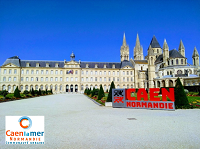Orateur
Description
We investigate how vector-isoscalar and vector-isovector interactions can be determined within the density regime of neutron stars (NSs), while fulfilling nuclear and astrophysics constrains. We make use of the Chiral Mean Field (CMF) model, a SU(3) nonlinear realization of the sigma model within the mean-field approximation, for the first time within a Bayesian analysis framework. We show that neutron-matter $\chi$EFT constraints at low density are only satisfied if the vector-isovector mixed interaction term is included, e.g., a $\omega^2\rho^2$ term. We also show the behavior of the model with respect to the conformal limit. We demonstrate that the CMF model is able to predict a value for the parameter $d_c$ related to the trace anomaly and its derivative takes values below 0.2 above four times saturation density within a hadronic version of the model that does not include hyperons or a phase transition to deconfined matter. We compare these effects with results from other (non-chiral) Relativistic Mean Field models to assess how different approaches to incorporating the same physical constraints affect predictions of NS properties and dense matter equations of state. We also include data from the gravitation wave event GW230529 detected by the LIGO-Virgo-Kagra collaboration and the most recent radius measurement of PSR J0437-4715 from the NASA NICER mission. Our analysis reveals that this new NICER measurement leads to an average reduction of approximately $\sim 0.1$ km radius in the posterior of the NS mass-radius relationship.

